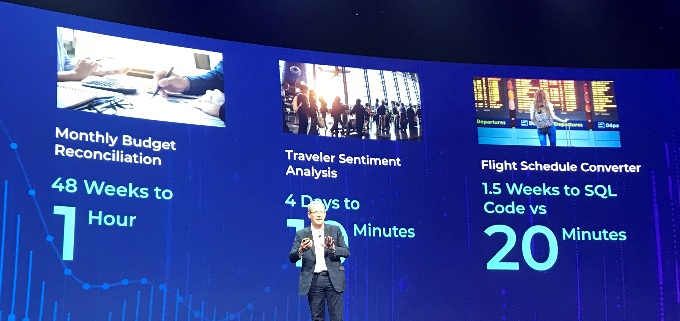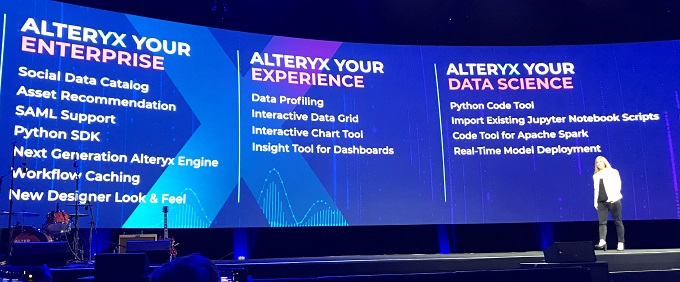Alteryx adds repeatability, automation features so analysts can streamline data prep, step up predictive analysis.
Alteryx eliminates tedious and time-consuming data-prep work so users can spend more time on innovative, advanced analytical work.
This was the core appeal articulated at Alteryx Inspire, the company’s annual customer conference held June 4-7 in Anaheim, CA. Riffing on the event theme “Alter Everything,” CEO Dean Stoecker encouraged the more than 3,000 Inspire attendees to use Alteryx to eliminate error-prone, repetitive spreadsheet drudgery and drive transformations and new business opportunities through data science.
Alteryx CEO Dean Stoecker shares examples of customers that gained time through repeatable data prep and transformation that they could redirect toward analytical innovation.
Alteryx laid out more than a dozen significant product enhancements at Inspire. It also set forth a roadmap toward machine-learning-based recommendation features and cloud-based deployment options coming to future releases. Here’s a closer look.
Alteryx Upgrades for 2018
Alteryx offers four products that it’s moving to synthesize into a tightly integrated platform. The core product that all customers use is Alteryx Designer, a desktop data-prep, blending and analytical tool that was introduced in 2006. Alteryx Server, added in 2010, provides a platform for connecting to data sources, collaborating around and automating Alteryx data workflows, and executing at big data scale. Today the vast majority of Alteryx revenue comes from an even split of Designer and Server licenses, but the company introduced two new products in 2017.
Using proceeds of its March 2017 IPO, Alteryx made two acquisitions in June 2017. Building on the acquisition of Semanta, a data cataloging and governance vendor, the company introduced Alteryx Connect, which offers data-discovery and collaboration capabilities. The assets of Brooklyn, NY-based startup Yhat were developed into Alteryx Promote, which supports analytical model deployment, monitoring and ongoing optimization.
The key announcements at Inspire were around more than a dozen upgrades across all four products. Some of these upgrades are already available, some are set for later this year and a few won't be available until next year. Demos of several of these upgrades drew raves from attendees while offers seemed overdue. Highlights included:
A social data catalog and asset recommendations. Search enhancements now generally available make it easier for users to find the data they’re after. In Q3 Alteryx will beta release an upgrade whereby users will get recommendations on the most popular data sources blended with a particular data source when they drag and drop it into a workflow.
Workflow caching. This upgrade, set for beta release in Q3, makes it easier to develop reusable data-prep and data-processing workflows by saving interim steps during an iterative design session.
Data profiling. Now generally available, this feature provides statistical details on the number of records, range of values, average value and other details about data set. Quality stats, such as the percentage and number of missing or exception values, will be useful in driving cleanup recommendations.
Python SDK. Alteryx already offered extensive support for use of R-based models, but with so much analytical development moving to Python, Alteryx has added an SDK supporting analytic development in this ascendant language.
Interactive Data Grid. These enhancements to Alteryx Designer’s core interface, planned for Q3 and beyond, drew hearty applause from customers, as it will make it easier for users to search, sort and filter their data without leaving Alteryx.
Alteryx VP of Product Management Ashley Kramer introduces the long list of upgrades the company has planned for 2018 and beyond.
MyPOV on Alteryx Upgrades: As noted, some of these upgrades, like key data-source connectors for Alteryx Connect, SAML support in Alteryx Connect and Alteryx Server, and the addition of data profiling and the Python SDK, seemed overdue. The workflow caching, Interactive Data Grid and a new Insight Tool for dashboards (which are all future enhancements) were real crowd pleasers. They look like they’ll deliver more problem-solving shortcuts around what would otherwise require tedious and repetitive manual work. Overall Alteryx seems to have stepped up its pace of development, so I’d expect less catch-up development and more innovative new feature development in future releases.
On the Horizon
Alteryx has plenty of competition both from dedicated data-prep vendors, such as Trifacta and Paxata, on the one hand, and advanced analytics vendors, such as RapidMiner, Knime and Domino Data, on the other (DataRobot and H2O are partners). Adding to the competitive pressure on Alteryx has been efforts by the likes of Tableau, Microsoft PowerBI, Qlik and other mainstream analytics vendors to add basic data-prep capabilities.
Roadmap themes going forward for Alteryx include:
- Knit together Connect, Designer, Server and Promote more closely to support seamless, end-to-end analytic workflows.
- Add machine-learning based capabilities across the platform to augment the skill of humans and support automation.
- Build out a container-based cloud deployment approach to support consistent, reusable use of the platform in hybrid and multi-cloud deployment scenarios.
Specific developments on the horizon include a Solution-Based Modeling Utility that will walk business analysts through the predictive modeling steps of data prep, analysis, model building and deployment through a wizard-driven interface. Also coming, in the ML vein, are data formatting, cleansing and join recommendations and natural language query capabilities.
MyPOV on Alteryx. I know from prior research (like this case study on Ford) that Alteryx is a great, time-saving and democratizing option for companies looking to make data-driven decision-making more of a self-service proposition. As was abundantly evident at Inspire, the company is growing quickly and has plenty of enthusiastic users of Alteryx Designer and Alteryx Server.
What remains to be seen is how successfully the company’s new products, Connect and Promote, can be knitted tightly into inseparable platform. Plenty of customers at Inspire told me they are considering adding these components, but few have done so as yet. A notable exception was Shell Oil Company, which offered a presentation on how it’s using Alteryx Promote as part of an effort to spread ML-based predictive analytical capabilities across the company.
What also remains to be seen is the extent to which native data-prep capabilities coming from the likes of Tableau will sap demand for more Alteryx licenses. Alteryx execs contended that these moves will only seed more demand for its platform. Whether entry-level prep happens in Alteryx or not, I see the company’s expanding analytical and model-deployment capabilities as the company’s bigger opportunity. Prep is something to get out of the way and make repeatable. Analytics is where companies are going to get more bang and business impact for the buck.
Releated Reading:
Qlik Hits Reset Button, Rolls Out New Cloud, AI & Developer Capabilities
MicroStrategy Makes Case for Agile Analytics on its Enterprise Platform
Ford Analytics Team Democratizes Data-Driven Analysis




